 Below is the list of plants I asked Aubrey King up at Kings Nursery in Tenaha to find for me for the landscaping of my new home several years ago. The plants were for the mere bones of my garden. I would, of course, add more later, but these were the ones with which I needed to start.
Below is the list of plants I asked Aubrey King up at Kings Nursery in Tenaha to find for me for the landscaping of my new home several years ago. The plants were for the mere bones of my garden. I would, of course, add more later, but these were the ones with which I needed to start.
2 Trachycarpus fortunei (6 ft. clear trunk)
3 15 gal. crape myrtles (cutvars don’t know yet?)
32 Nandina domestica
3 Ellan Bosanquet crinum
10 Creeping fig (Ficus pumila)
1 Fig (Celeste or you pick variety)
4 Michelia figo
1 Camellia (you pick the variety)
1 Spirea Vanhouttei
28 Pink Formosa ‘Judge Solomon’
375 Big Blue Liriope 4”
1000 Dwarf Monkey Grass 4”
3 Bignonia
1 Gardenia (Gardenia jasminoides)
1 Zephrine Drouhin rose
1 Cornelia rose
7 Dwarf Indian Hawthorn
You will notice that one of the plants I included was the gardenia. My wife insists on having this plant around her. In our early marriage we traveled from apartment to apartment as I went from school to school, and she grieved every summer that we went without one. I could have put one in a pot (they do well in pots), but somehow potted shrubs didn’t appeal to me. But as soon as we had a bit of earth, we had gardenias.
For my wife, the flowering of gardenias is a sign of the coming of summer, and usually they are in full bloom around her birthday in May. So, this month, when the gardenia Aubrey King sold me came into bloom, she was a happy camper.
The gardenia (Gardenia jasminoides) is a Chinese introduction that was named for a botanist of South Carolina, Dr. Alexander Garden, who lived in the 1700’s. It’s fitting that an American Southerner has his named attached to this plant, for it is one of the great standards of the South. There are 350 species in the genus, but it is jasminoides or ‘Cape Jasmine’ with which we are most familiar. ‘Cape Jasmine’ then is the classic term for this beloved attractive shrub of the South.
The foliage is a glossy evergreen with leaves two to five inches long that are leathery and relatively coarse textured. The shrub will get six feet wide and eight feet tall, but on average is somewhat smaller. But it is the flower and fragrance that is the allure. The old fashion ‘Cape Jasmine’ flower is creamy white, double and blousey in appearance and fragrant, very fragrant. There are few plants with a fragrance as unique. Once you take in its scent, it rivets itself into your memory. The fragrance of ‘Cape Jasmine’ probably brings up memories for just about everyone.
Billy Wall who once lived up on North Street said that the fragrance and bloom of ‘Cape Jasmine’ reminded him of funerals. In his childhood it was traditional to bring them. For my wife the fragrance of ‘Cape Jasmine’ is just summertime. Glorious summer when school is out and you can play all day long outside with the neighbor kids and come in, get washed up; and, as drift off to sleep, smell the fragrance outside the window.
The ‘Cape Jasmine’ has a relatively attractive mounding form. It is often used in mass plantings or as a hedge, but keep this in mind if you are considering investing in a large planting of gardenias. They are very sensitive to poorly drained, heavy soils. In fact, the soil where you grow a gardenia is most important; so, if your are planting a hedgerow of gardenias or a mass planting, prepare the soil very well. Planting any hedge is problematic, but especially so with a gardenia; for if you prepare the soil along the hedge line with lots of organic matter but somewhere there is a low spot or a section of poorly drained and tight soil, then it’s very likely that the plants in that portion of the hedge line will die, leaving your hedgerow snaggle-toothed. Prepare hedge row lines carefully!
I personally think that a gardenia is a good specimen plant set some place where there is space around it, air and filtered light. You might say, “Isn’t air obvious?” Gardenias attract several pests: spider mites, white fly, etc., so they seem to do best out by themselves where they get a lot of air and are less likely to be attacked as they often are in dense landscapes.
Also, gardenias like acidic soils. My parents grew gardenias, and sometimes I thought we drank a lot of iced tea so that my mother would have plenty of tea leaves to put on that gardenia’s roots. She loved gardenias just like my wife. In the end gardenias are perfect for East Texas where the soils are acidic and the climate is warm and where we here love nighttime breezes with gardenia.

One response to “Cape Jasmine”
Good way of telling, and pleasant piece of writing to take facts about my presentation subject matter, which i am going to convey in university.